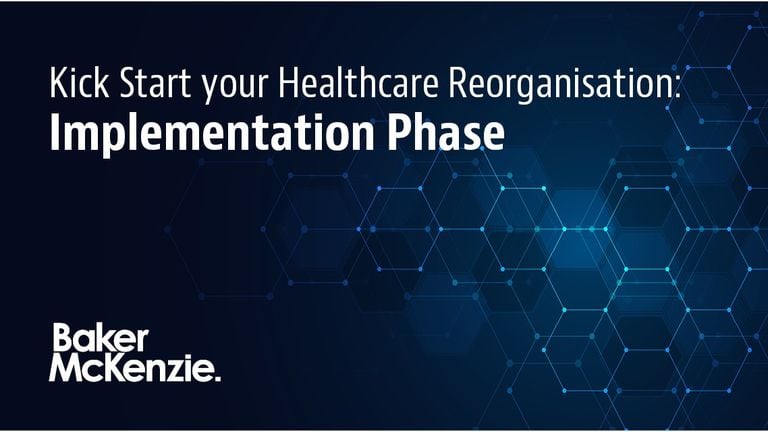In the second post of our ‘Kick Start your Healthcare Reorganisation’ series we focus on the implementation phase of a healthcare and life sciences reorganisation and specifically the following three areas:
- document execution;
- funds flow; and
- operational go-live.
Whilst each area is individually significant, and is likely to have its own dedicated workstream, it is important to recognise that they each go hand in hand when looking to achieve smooth (and successful) implementation.
Document execution
First, on multi-jurisdictional projects, with a large number of entities involved, tens if not hundreds of signatories and various time zones to contend with, it is essential that the authorised signatories are identified early and their availability to sign documents is confirmed. This includes, for example, execution of documents virtually (e.g. via Docusign), in wet ink and/or in the presence of a witness or notary. The lead time required for document formalities such as obtaining an apostille, legalisation or official translation should also be considered, as well as the jurisdiction in which execution needs to take place.
Secondly, consideration should be given to when documents can be signed (i.e. in advance versus on the day of implementation). If on the day of implementation, does the timing of execution impact the sequencing of other steps or do meetings have to take place in a particular order? These are all items that can be meticulously planned in advance to help streamline the implementation process and ultimately mitigate execution risk.
Funds flow
A key factor that must be considered when planning for a reorganisation is how transaction steps will be funded at the local subsidiary levels, for example out of working capital, through debt (intragroup or external), injection of equity or left outstanding on intercompany account with the resulting balances needing to be cleaned-up post-implementation.
The funds flow itself is also critical, especially where multiple back-to-back wire transfers are required on the same day. One way to mitigate potential execution risk with the movement of physical cash is to reduce the number of actual payments that need to be made. Asking whether it is possible to complete transactions by way of payment direction letter in order to offset and settle intercompany payables on a cashless basis can lead to significant efficiencies.
Where multiple bank transfers are required, it is important to work closely with the Treasury team as global projects often bring about added complexity when working with banks across time zones. In addition, where physical cash payments are required, it is necessary to confirm the relevant currency, FX exposures and whether the local entities involved have operational bank accounts as opening new accounts and completing relevant KYC can complicate (and delay) implementation.
Operational go-live
This is the day of completion and the point at which the reorganised business is expected to operate independently. So, will you be ready?
Key considerations to ensure everything is in place for operational go-live include:
- Employees – have they been transferred across and/or onboarded as needed and have you set up payroll to ensure wages can be paid on time, are HR systems ready to go-live?
- Premises – where will your employees work from or where will you hold inventory/stock, are sub-leases, licences or other sharing arrangements and logistics in place?
- IT Systems – has the IT been properly set up and tested to enable the business to operate, will invoices be generated correctly with the right names, numbers, customer details?
- Contracts – have your suppliers and customers transferred across so you can retain business continuity, are there measures in place in case of misallocated orders, deliveries and payments?
- Cash in bank – does the business have sufficient working capital to operate from Day 1, is the cash pool live, are there facilities in place in case of urgent cash requirements?
Key to ensuring seamless implementation is to communicate with all stakeholder groups to ascertain business critical items for Day 1 and identify all interdependencies, understanding what is needed immediately and what can be built up over time.
If you would like to discuss in more detail any plans your business may have for a reorganisation, please contact Rakesh Rathod, Charlotte Nolan and Katie Sewell or your usual Baker McKenzie contact. We would be delighted to assist.
And stay tuned, in our final post of this series we will take you from implementation to post-implementation considerations for a healthcare reorganisation.
Click here to view the first post in this series – Kick Start your Healthcare Reorganisation (1 of 4)
Click here to view the second post in this series – Kick Start Your Healthcare Reorganisation: Planning Phase (2 of 4)
Click here to view the final post in this series – Kick Start your Healthcare Reorganisation: Post-Implementation Phase (Post 4 of 4)






